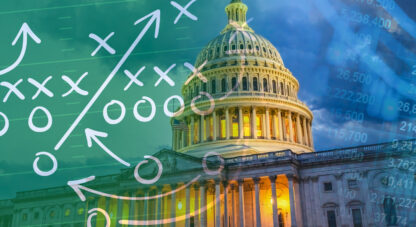Weekly Hard Asset Insights
By David McAlvany
We are now halfway through October, and, make no mistake about it, what we have on our hands is a truly fascinating market environment. Within the global economy and markets, incredibly big risks abound that argue for sharply lower prices. At the same time, there are some increasing signs that blow-off top, crack-up-boom dynamics may be in play that are pressuring prices even higher. Just to keep the drama high, this week market indexes rallied sharply and broke above key technical resistance levels, leaving prices set to test upside potential.
In this week’s HAI, lets take stock of where we are and appreciate the fat tails of potential near-term outcomes vying for supremacy in market price dynamics. The near-term for this market holds both the potential for dramatic declines and the potential for a boom higher. As a result, in our current environment, market participants need to be prepared, and carry water on both shoulders.
On Wednesday, the US Labor Department reported that headline CPI consumer prices jumped 0.4% in September, beating analysts’ expectations of a 0.3% increase. On an annual basis, consumer prices are now up 5.4%, representing the highest level of inflation since 1991. Core CPI, excluding food and energy, rose 0.2% on a monthly basis and 4% annually.
On Thursday, US PPI, the Producer Price Index data, was released and offered a bit of good news on the inflation front. In September, PPI increased to 8.6% on an annual basis versus the expected 8.7%. Despite coming in slightly lower than expected, the number still marked the biggest year-over-year jump in wholesale prices since 2010. On a monthly basis, PPI increased by 0.5% in September, less than August’s 0.7% pace of increase. Core PPI, excluding food and energy prices, increased at 0.2% for September, also less than August’s advance of 0.6%. Annually, the core PPI rose 6.8% versus the expected 7.1%.
While some of this inflation news was positive, other indications continue to flash inflation warning lights. According to Barron’s, “September’s CPI report was notable for the broadening of the inflationary impulse more than its actual level.” Embedded in the details of the report was evidence that after previous monthly CPIs were primarily driven by their more flexible price components, in the September CPI, “the baton is now being passed to ‘sticky’ CPI, which has just broken out to a new 13-year high….”
Even more concerning is that these sticky components are just starting to gain stream. Case in point would be shelter prices, which account for one-third of CPI, and rose 0.4% monthly and 3.2% annually. CPI shelter inflation measures significantly lag most market measures of housing and rent price increases, and still have a very long way to go before catching up and reflecting current, much higher, market price reality. Similarly, the labor market will likely increasingly contribute to rising prices. With two straight weaker-than-expected employment reports, huge numbers of unfilled job openings, and a wave of resignations (over 4.3 million employees quit their jobs in the last month of reporting), all signs point to increasing wage inflation pressures going forward.
In addition, while excluded from “core” readings of both CPI and PPI, we are seeing food and energy prices continuing to rise to concerning levels. Oil has now broken well above the key $80 level, and food prices, according to the Food and Agriculture Organization, have accelerated to two consecutive months of decade highs.
Perhaps following energy’s lead, we are now seeing base metals prices begin to surge higher again after months of cooling off. Copper closed this week up over 10% at $4.73/lb, the highest level since the May 12th all-time high of $4.89/lb. Meanwhile, inventories available on the London Metal Exchange are at the lowest levels since 1974. Michael Widmer, head of metals research at Bank of America, said in a Bloomberg interview that, “If more metal doesn’t make it into the exchange, then it really is in a difficult position…. Right now the LME is running a physical contract that effectively is not really backed by physical metal.”
Adding to the inflationary brew, referring to the recent breakout higher in energy prices, Saxo Bank analyst Ole Hansen said, “High power costs are also inflationary and this is boosting demand from investors for copper and other physical commodities as a hedge…. It looks like we’ve got clear air ahead of us to that May peak.” The resumption of rapidly rising commodity prices is highly significant to the inflation issue, and adds another inflationary component to the broad-based basket of price increases.
At the same time, much of the “transitory” inflation argument has been premised on Covid-related supply chain disruptions swiftly resolving themselves. In a recent Bloomberg interview, however, Sultan Ahmed Bin Sulayem, the Chairman and CEO of DP World, one of the largest international port operators, offered a sobering assessment of the supply chain issues. Bin Sulayem stated that, “The global supply chain was in crisis at the beginning of the pandemic,” and said, “Maybe in 2023 we’ll see an easing.” If his assessment proves correct, the inflation problem grows exponentially as a whole host of inflation components thought to be in the flexible and transitory category suddenly reclassify as persistent.
Speaking on Bloomberg to the latest inflation data, former US Treasury secretary Larry Summers said Friday that, “…we’re seeing exactly what you would have expected with a central bank behind the curve. We’re seeing an explosion in particular components in bottlenecks giving way to a more generalized inflation. We saw it in specific components early a few months ago…those components receded a bit, but now we see inflation becoming more widespread in a wider range of products spreading to the housing and labor markets. I’ve been alarmed for a long time and I’m more alarmed now.”
On Wednesday, The Federal Reserve released minutes from its most recent September policy meeting. According to the minutes, the Fed looks to cut its $120 billion of Treasury and mortgage-backed securities by $10 billion a month for Treasurys, and $5 billion a month for mortgage-backed securities. The Fed indicated that the tapering will likely begin by as early as the middle of next month or by the middle of December. Additionally, in a notable change from the summer months, the minutes suggested Fed policymakers are increasingly worried about inflation. The minutes revealed that “most” policymakers now see upside risks to inflation, and that “some” are concerned that the current inflationary environment will feed through to inflation expectations and eventually to even higher future prices.
This shift toward greater concern about inflation is also apparent at the International Monetary Fund. This week, Gita Gopinath, the IMF’s chief economist, said that while it was too early to “say anything about stagflation,” inflation risks appear “skewed to the upside” and risks for growth look “tilted to the downside.” Gopinath also advised that central banks should act if there are signs that inflation expectations are picking up. “What [central banks] have to watch out for is the second-round effects [with] these increases in energy prices feeding into wages and then feeding into core prices. That’s where you have to be very, very vigilant….”
On that note of inflation expectations, this week the NY Fed’s survey on consumer inflation expectations came in hot again. As of September, expectations for one-year-ahead inflation increased to 5.31%, which was an 11th straight monthly increase and a new series high reading. Interestingly, a full quarter of the respondents expected year-ahead inflation of a whopping 8.7%. Three-year inflation expectations also ratcheted higher to a new series high of 4.19% from last month’s 4.00% reading.
Let’s back up for a moment to the IMF’s comment that risks to growth are “tilted to the downside.” The Federal Reserve Bank of Atlanta keeps a running GDPNow forecast for real US GDP. As recently as August, the reading for Q3 GDP was as high as 6.3%. As of the Friday October 15 reading, the same Q3 GDP forecast was 1.2%. So while the IMF says inflation risks are to the upside, growth risks are to the downside, but it’s too early to “say anything about stagflation,” one might be wise to seriously consider the risk of just such a stagflationary environment developing. This may prove all the more likely if the Federal Reserve is forced by inflation to taper faster and eventually raise interest rates ahead of expectations.
Also adding credibility to growth concerns are recent consumer sentiment surveys. The latest University of Michigan preliminary survey of consumers, out on Friday, showed that, “Consumer sentiment has remained for the past three months at the lows first recorded in response to last year’s shutdown of the economy.” After sentiment plunged in August, readings saw a slight improvement in September, and it was hoped that the rebound would continue into October. Rather than improve, however, preliminary October sentiment declined to a 71.4 reading from September’s 72.8 reading. The decline was a significant miss of the expected increase to a 73.1 reading. The sentiment score was the second lowest reading since 2011, as the survey indicated weakening in current economic conditions as well as the economic outlook. A separate Rasmussen economic confidence index confirms the weak sentiment. The Rasmussen index declined in September for the fifth consecutive month to the lowest levels since May of 2020.
Relevance of all this to the stock market? The risk of a brewing stagflationary environment with high inflation and lowering growth certainly has direct risks to earnings. As Mike Wilson, Chief US market strategist at Morgan Stanley, put it during a Bloomberg interview on Friday, “…the inability of companies to pass on pricing…margin risk, related to higher wages, and the reversion to trend in goods consumption pose a serious risk to companies’ earnings prospects.” Wilson goes on to say that while he sees room for the market to keep rallying in the near term as we enter a seasonally strong period for stocks, he says that will be “until the engraved invitations go out about earnings estimates for next year.”
With valuations at historically high levels and a Fed that looks increasingly worried about inflation and more likely to go forward with tapering and rate increases, all while earnings look set to fall away, an environment conducive to serious market declines appears set to develop. The question is, when? Well, Wilson sees trouble for equity prices once we hit the new year. With that said, events in China still stand as a massive wild card. On its own, the China string is significant enough that pulling it could fully unravel all the neat knitting that is our historic and epic bull market.
The Fed certainly has a situation on its hands. It has facilitated a raging market bubble, a debt crisis, a brewing non-transitory inflation problem, and a market and economy that have become dependent on the very liquidity and loose financial conditions responsible for causing and inflaming all of these problems. The array of market issues may be set to come to a head, but, at the same time, each and every energetic rally that shrugs off any and all concerns risks initiating a proper blow-off momentum move, and even a full-fledged Austrian crack-up-boom.
Karen Petrou is a highly respected bank policy analyst and the co-founder and managing partner of Federal Financial Analytics, Inc., a reputable Washington-based financial services-consulting firm. In a recent Barron’s op-ed, Petrou described the Federal Reserve’s worrying predicament in eloquent terms.
“The problem with policy quagmires isn’t knowing you should get out; it’s getting out. … Each way out seems blocked, so it gets in ever deeper, but ever deeper is ever more dangerous. The more the Fed perpetuates markets that depend only on central-bank largesse, not price discovery and disciplinary correction, the greater the risk that inescapable retreat leads to costly casualties.”
Non-transitory high levels of inflation could force inescapable retreat. If so, expect casualties. On the other hand, further delay of a Fed retreat runs the risk of a crack-up-boom and an even greater eventual bust.
As for weekly performance: The S&P 500 closed the week up 1.82%. Gold was higher by 0.62% and silver gained 2.84% on the week. Platinum was up 2.99%. Palladium was nearly flat, up 0.17%. The HUI gold miners index put in a second consecutive good week, up 6.24%. The IFRA iShares US Infrastructure ETF was up 2.02% for the week. Energy commodities were mixed. WTI crude oil gained 3.69%, closing well over the important $80 level at $82.28. Natural gas, on the other hand, was down 2.79% on the week. The CRB Commodity Index was up 1.62%, while copper surged by 10.63%. The Dow Jones US Real Estate Index ended the week up 3.18%, while the Dow Jones Utility Average Index gained 1.56%. The US Dollar Index was slightly lower this week by 0.13% to close the week at 93.96. The yield on the 10-year Treasury declined by 2 bps to close the week at 1.59%.
Have a great weekend!
Best Regards,
David McAlvany
Chief Executive Officer
MWM LLC















